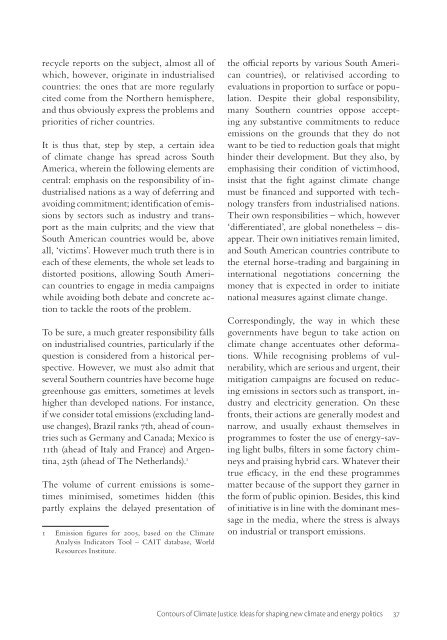Contours of Climate Justice - Dag Hammarskjöld Foundation
Contours of Climate Justice - Dag Hammarskjöld Foundation
Contours of Climate Justice - Dag Hammarskjöld Foundation
Create successful ePaper yourself
Turn your PDF publications into a flip-book with our unique Google optimized e-Paper software.
ecycle reports on the subject, almost all <strong>of</strong><br />
which, however, originate in industrialised<br />
countries: the ones that are more regularly<br />
cited come from the Northern hemisphere,<br />
and thus obviously express the problems and<br />
priorities <strong>of</strong> richer countries.<br />
It is thus that, step by step, a certain idea<br />
<strong>of</strong> climate change has spread across South<br />
America, wherein the following elements are<br />
central: emphasis on the responsibility <strong>of</strong> industrialised<br />
nations as a way <strong>of</strong> deferring and<br />
avoiding commitment; identifi cation <strong>of</strong> emissions<br />
by sectors such as industry and transport<br />
as the main culprits; and the view that<br />
South American countries would be, above<br />
all, ‘victims’. However much truth there is in<br />
each <strong>of</strong> these elements, the whole set leads to<br />
distorted positions, allowing South American<br />
countries to engage in media campaigns<br />
while avoiding both debate and concrete action<br />
to tackle the roots <strong>of</strong> the problem.<br />
To be sure, a much greater responsibility falls<br />
on industrialised countries, particularly if the<br />
question is considered from a historical perspective.<br />
However, we must also admit that<br />
several Southern countries have become huge<br />
greenhouse gas emitters, sometimes at levels<br />
higher than developed nations. For instance,<br />
if we consider total emissions (excluding landuse<br />
changes), Brazil ranks 7th, ahead <strong>of</strong> countries<br />
such as Germany and Canada; Mexico is<br />
11th (ahead <strong>of</strong> Italy and France) and Argentina,<br />
25th (ahead <strong>of</strong> The Netherlands). 1<br />
The volume <strong>of</strong> current emissions is sometimes<br />
minimised, sometimes hidden (this<br />
partly explains the delayed presentation <strong>of</strong><br />
1 Emission fi gures for 2005, based on the <strong>Climate</strong><br />
Analysis Indicators Tool – CAIT database, World<br />
Resources Institute.<br />
the <strong>of</strong>fi cial reports by various South American<br />
countries), or relativised according to<br />
evaluations in proportion to surface or population.<br />
Despite their global responsibility,<br />
many Southern countries oppose accepting<br />
any substantive commitments to reduce<br />
emissions on the grounds that they do not<br />
want to be tied to reduction goals that might<br />
hinder their development. But they also, by<br />
emphasising their condition <strong>of</strong> victimhood,<br />
insist that the fi ght against climate change<br />
must be fi nanced and supported with technology<br />
transfers from industrialised nations.<br />
Their own responsibilities – which, however<br />
‘diff erentiated’, are global nonetheless – disappear.<br />
Their own initiatives remain limited,<br />
and South American countries contribute to<br />
the eternal horse-trading and bargaining in<br />
international negotiations concerning the<br />
money that is expected in order to initiate<br />
national measures against climate change.<br />
Correspondingly, the way in which these<br />
governments have begun to take action on<br />
climate change accentuates other deformations.<br />
While recognising problems <strong>of</strong> vulnerability,<br />
which are serious and urgent, their<br />
mitigation campaigns are focused on reducing<br />
emissions in sectors such as transport, industry<br />
and electricity generation. On these<br />
fronts, their actions are generally modest and<br />
narrow, and usually exhaust themselves in<br />
programmes to foster the use <strong>of</strong> energy-saving<br />
light bulbs, fi lters in some factory chimneys<br />
and praising hybrid cars. Whatever their<br />
true effi cacy, in the end these programmes<br />
matter because <strong>of</strong> the support they garner in<br />
the form <strong>of</strong> public opinion. Besides, this kind<br />
<strong>of</strong> initiative is in line with the dominant message<br />
in the media, where the stress is always<br />
on industrial or transport emissions.<br />
<strong>Contours</strong> <strong>of</strong> <strong>Climate</strong> <strong>Justice</strong>. Ideas for shaping new climate and energy politics 37
















